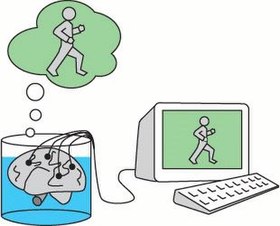
Back دماغ في وعاء Arabic একটি পাত্রে মস্তিষ্ক Bengali/Bangla Teoria del cervell en una cubeta Catalan Hjerne i et kar-hypotesen Danish Gehirn im Tank German Cerebro en una cubeta Spanish Aju tõrres Estonian Burmuin bat kubo batean Basque مغز در خمره Persian Aivot altaassa Finnish

In philosophy, the brain in a vat (BIV) is a scenario used in a variety of thought experiments intended to draw out certain features of human conceptions of knowledge, reality, truth, mind, consciousness, and meaning. Originated by Gilbert Harman,[1] Hilary Putnam turned the scenario into a modernized version of René Descartes's evil demon thought experiment. Following many science fiction stories, the scenario involves a mad scientist that might remove a person's brain from the body, suspend it in a vat of life-sustaining liquid, and connect its neurons by wires to a supercomputer that would provide it with electrical impulses identical to those a brain normally receives.[2] According to such stories, the computer would then be simulating reality (including appropriate responses to the brain's own output) and the "disembodied" brain would continue to have perfectly normal conscious experiences, such as those of a person with an embodied brain, without these being related to objects or events in the real world. According to Putnam, the thought of "being a brain-in-a-vat" (BIV) is either false or meaningless. Considered a cornerstone of Semantic externalism, the argument produced significant literature. The Matrix franchise and other fictional works (below) are considered inspired by Putnam's argument.[3]
- ^ Harman, Gilbert 1973: Thought, Princeton/NJ, p.5.
- ^ Putnam, Hilary. "Brains in a Vat" (PDF). Archived from the original (PDF) on 6 October 2021. Retrieved 21 April 2015.
{{cite journal}}: Cite journal requires|journal=(help) - ^ Chalmers, David J (1 September 2004), "The Matrix As Metaphysics", Philosophers Explore The Matrix, Oxford University PressNew York, NY, pp. 132–176, doi:10.1093/oso/9780195181067.003.0009, ISBN 978-0-19-518106-7, retrieved 20 November 2023
© MMXXIII Rich X Search. We shall prevail. All rights reserved. Rich X Search